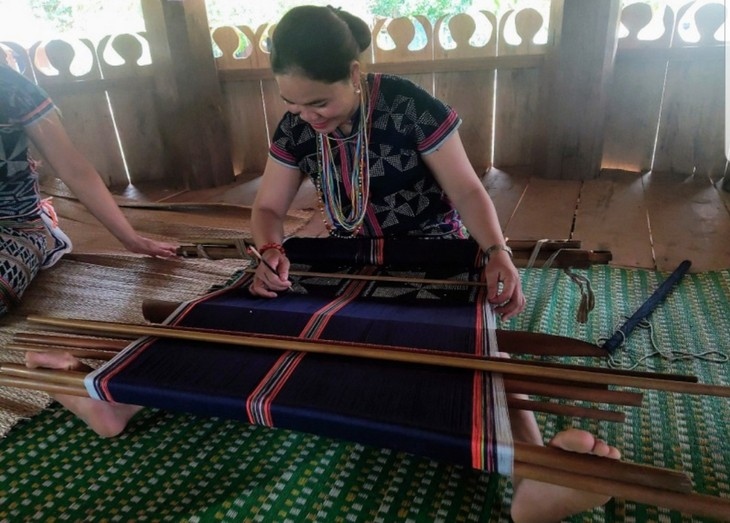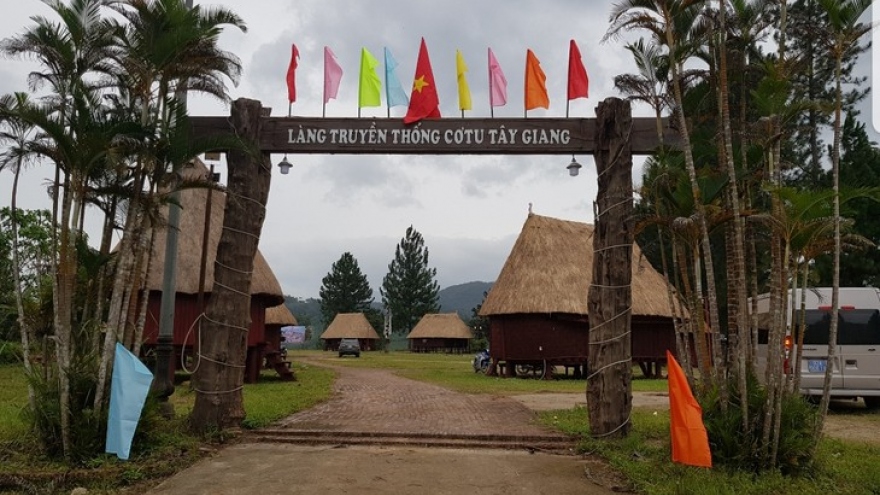Co Tu ethnic people keep their traditional brocade weaving alive
VOV.VN - Brocade weaving retains the traditional cultural characteristics of the Co Tu ethnic people.

The craft took shape since the Co Tu discovered the cotton tree (Kpay) originally growing in the forest, brought it back to grow on the mountain fields, and widely popularized it.
The Co Tu group is one of few ethnic minorities living in the Truong Son mountain range and the Central Highlands region that have maintained cotton farming and brocade weaving.
The Kpay tree was domesticated into the current native cotton tree with several different names such as “kpay plang”, “kpay lao”, and “kpay plung”, which scientists call “upperian cotton” or “cotton of grass”.
Every Co Tu girl of marriage age must know how to weave. This is considered a standard to evaluate the talent and virtue of a Co Tu woman.
Co Tu brocade products are made entirely by hand in a closed environment, said folklore researcher Vo Van Hoe, adding that the Co Tu have many traditional crafts such as brocade weaving, knitting, and sculpture.
“Brocade weaving is the most typical and important to the Co Tu. The outstanding difference is that their costumes are not as motley as those of ethnic minority groups in the Northwest, whose hats are decorated with lots of beads. The main colors of the Co Tu people’s costumes are black and red alternating with blue, white, and yellow, which they say, symbolize the mountains and forests,” Hoe explained.
He added black, for example, represents the earth, red for the sky, blue the forest and mountains, and white the embellishment color.
The Co Tu’s loom is primitively made only from bamboo sticks. The oldest loom which still exists today is called the Indonesian loom.
Despite the rudimentary structure and the limited ability to weave patterns, the loom can turn out the fabrics imbued with the cultural identity of the Co Tu who have also invented different tools for fiber processing.
Each product has a certain use and aesthetic value. Brocade fabrics, whether large or small, are special because of the creativity of the weaver. Co Tu brocade products can be distinguished by their cloth (aduong), shirt (adooh), robe (aday), loincloth (h’giăl or g’hul), and skirt (hdooh).
The Co Tu are famous for the techniques of weaving beaded patterns, colored thread patterns, wavy patterns, and stitching. The beads are woven directly into the product instead of being attached to the cloth. Inserting beads and creating patterns with beads are an extremely meticulous and elaborate process which creates the special value of Co Tu brocade costumes.
A Bing Thi Ngoc, a Lang villager in Quang Nam province, told VOV, “Whatever pattern I like, for example a leave I see in the forest, I’ll weave it that way. There are many colors depending on the person’s preference. Use whatever style you like.”
Generally, black is most favored in brocade weaving because it is the main color, said Ngoc, adding other colors, for example yellow, red, and blue, are used for more beautiful and vivid decoration.
“The patterns that we usually embroider on shirts are inspired by things around us like trees and leaves in the forest, birds, stilt houses, or a Gươl house,” said Ngoc.
Co Tu brocade weaving villages in Quang Nam are being restored.
Bh’ling Phat, head of Por’ning hamlet in Tay Giang district, affirmed that the good news is that the traditional brocade weaving is still preserved. The craft has been handed down from generation to generation.
“Many young people already know how to weave. Villagers weave brocade products mainly for daily needs or goods exchange. Our difficulty is the lack of outlets. According to Co Tu custom, a married woman must have a ‘Tut’, a shirt men wear in the ‘tung tung da dá’ folk dance, to give to her husband’s family,” said Phat.
In August 2014, the brocade weaving of the Co Tu people in Quang Nam province was listed as one of the national intangible cultural heritages.


